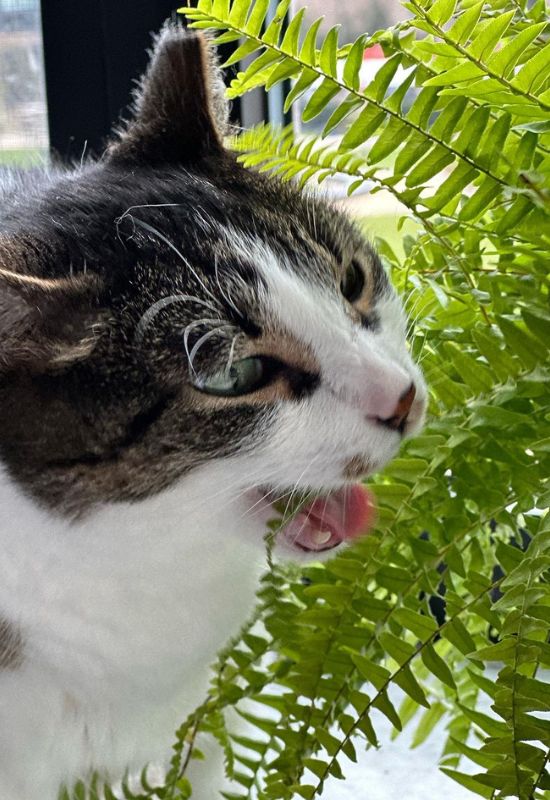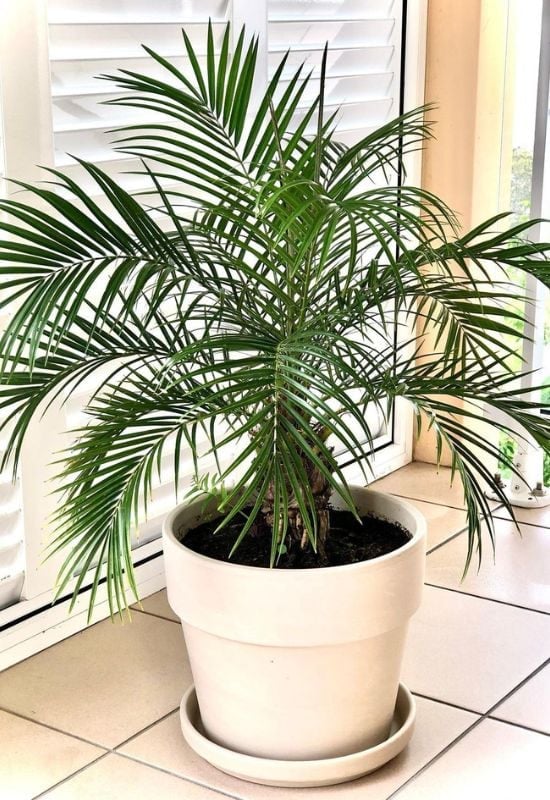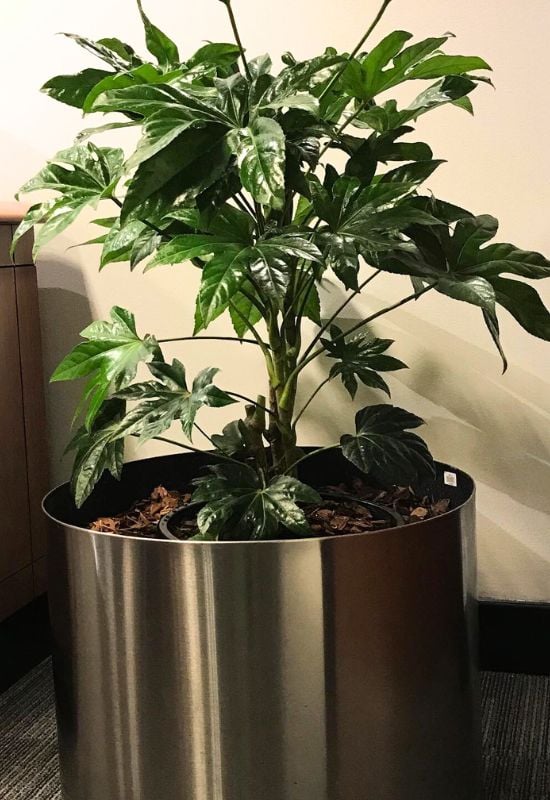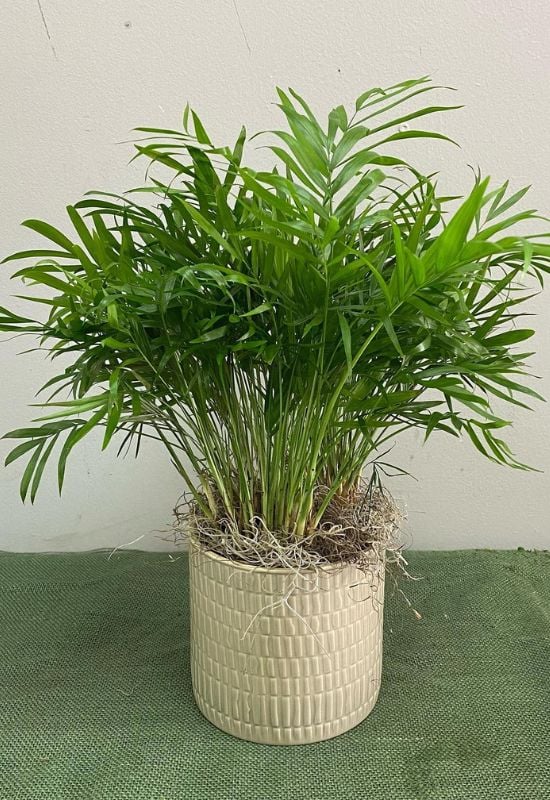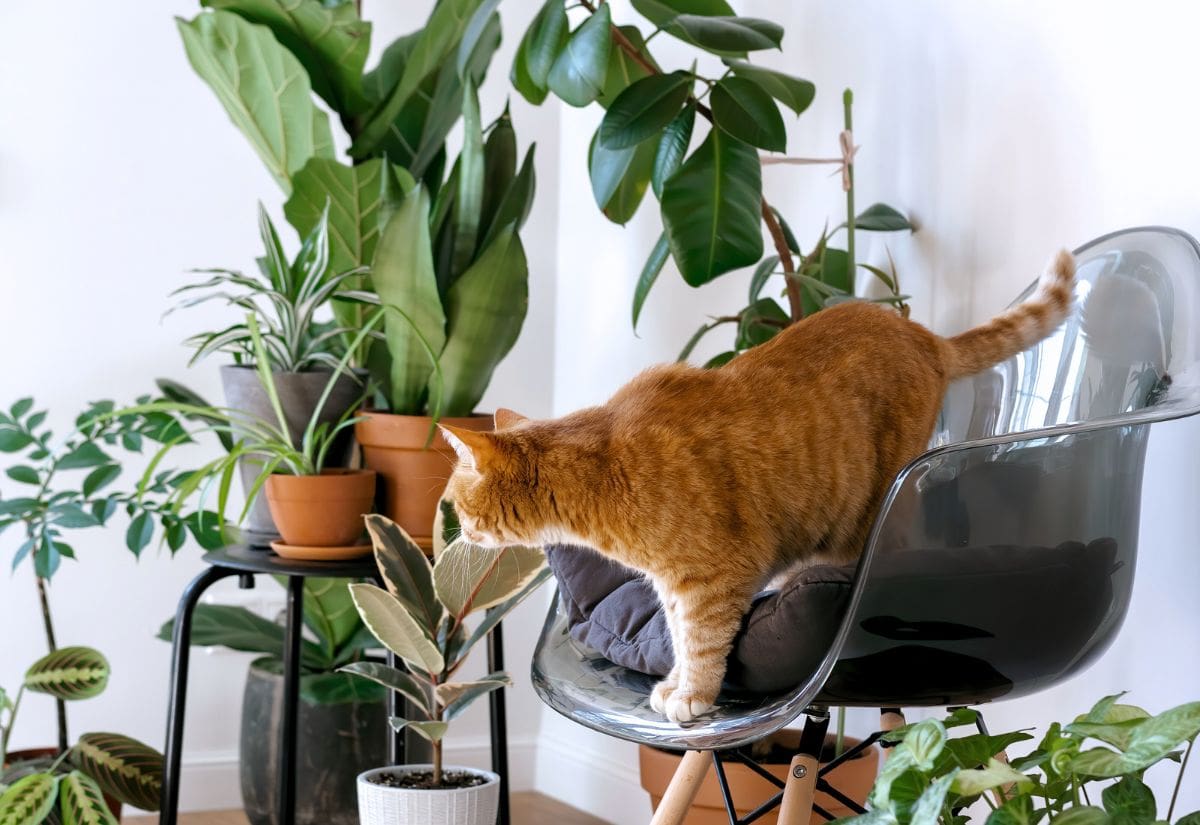
Watching your cat or kitten sneak through the lush tropical leaves of indoor trees may bring to mind images of a tiger crawling elegantly in a leafy rainforest… But how safe are houseplants for pets, and especially for your feline friends?
Some can be toxic and even poisonous to cats; others may pose physical hazards with their sharp leaves, thorns, or prickles. Naturally, you’d want to ensure your four-legged family members remain unharmed, steering towards indoor tree varieties that pose no threat to your cats.
True, cats are often savvy and smart, steering clear of danger. But as the saying goes, better safe than sorry. And the good news? You don’t have to forgo the exotic ambiance reminiscent of sun-kissed Pacific beaches, serene South American forests, or or even the sculptural beauty that some indoor trees bring to your home.
And I’m going to prove it to you: you can have safety for your cats and super decorative trees in your loving spaces coexisting in peace and harmony, and never worry for the health of your pets when you go out…
How? It’s straightforward—I’m here to introduce you to not only the safest but also the most beautiful cat safe trees you can grow indoors, ensuring the wellbeing of even the most mischievous felines in your household!
Indoor Trees and Cat Safety
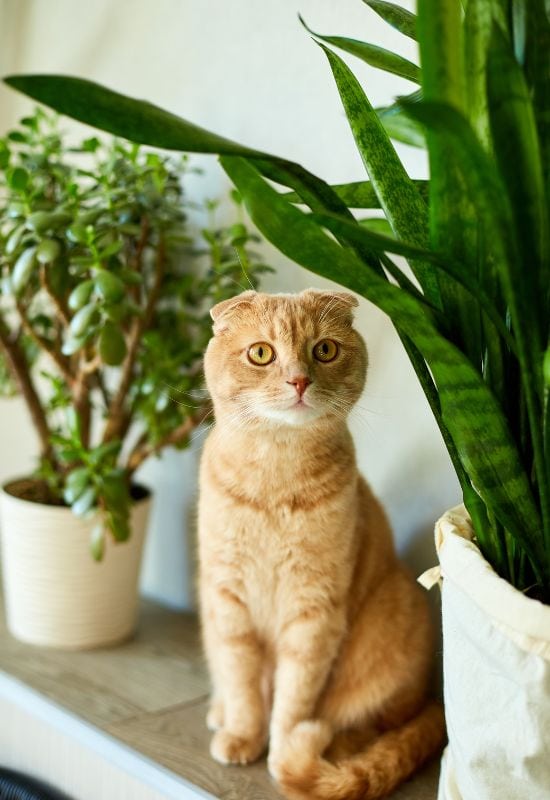
To be honest, cats are quite independent and wise; they will usually know if a plant is poisonous or toxic and won’t touch it.
But domesticated pets may lose part of this ability… What’s more, there are some houseplants that can irritate the skin to the touch, and these should be avoided at all costs, including the popular and innocent looking weeping fig (Ficus benjamina).
I have literally seen my small kittens jump through the long and menacing sharp thorns and prickles of a cactus and succulent botanical garden where I used to work… One passed a few inches from a massive spike with her eyes!
That’s because our feline friends have an eyesight that’s 8 times (!!!) more powerful than ours. And because they have amazing control on their movements…
But indoor spaces can be more dangerous, because they can get crammed, and when cats age, they may become less attentive and supple… For this reason, we should also avoid thorny houseplant and indoor tree varieties.
Indoor Trees, Humans and Pets – An Important Difference
Now, here is an important note for you… You think that a plant that’s safe for us, will automatically be safe for cats? Think again! There are many common varieties, even some that we use in cooking, that are safe for us but dangerous for our feline companions. For example bay laurel (Laurus nobilis) and even Aloe vera!
In fact, even borage (Borago officinalis) and – you won’t believe it – soothing and calming chamomile (Anthemis nobilis) will intoxicate your cats and make them sick, with vomiting, diarrhea and even long term effects.
And a final note on catnip (Nepeta cataria)… The name is misleading… And it can also trick our feline friends… In fact, cats do eat it, but in many cases, it will give them symptoms similar to food poisoning…
So, to be on the safe side, but without losing in decorative value, we can now start to see which indoor trees will never harm you your cat…
12 Indoor Tree Varieties That Are Purr-fectly Safe for Your Cat
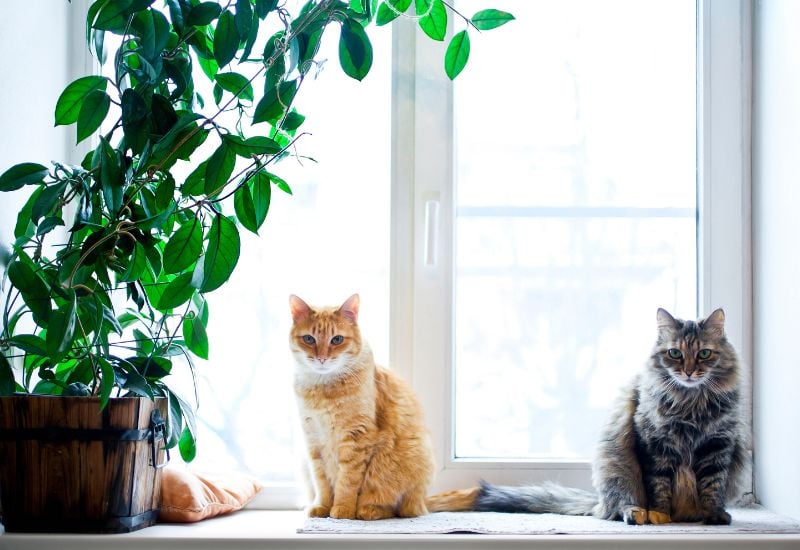
Unfortunately, many houseplants are toxic or dangerous for cats, and if you care about the safety of your feline friend, here are 12 you can fully trust.
These are all decorative indoor trees and I have added some tree like houseplants, and we will see them soon, but first, a few words on plants and the safety of your cat or kitten.
1: Flowering Banana (Musa ornata)
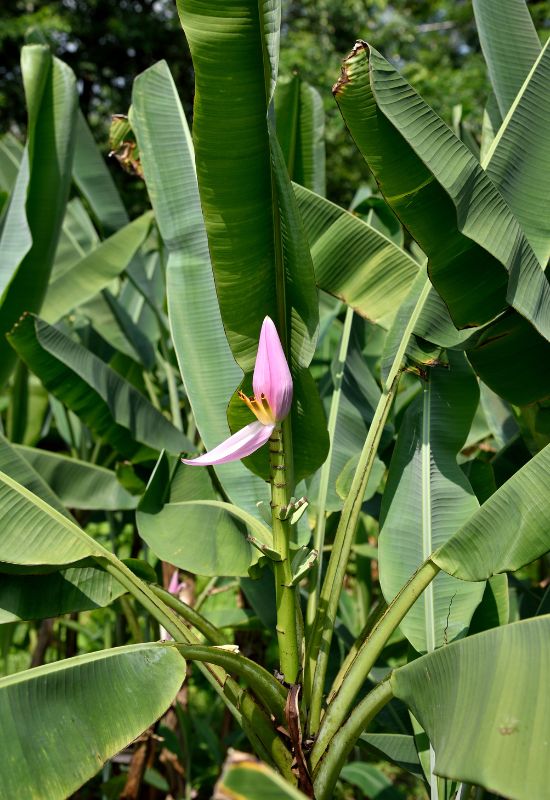
“Hold on, banana plants are not trees,” you may say. And you would be scientifically correct; in fact, they are massive grasses in botany. But in gardening terms, they are treated as trees, and you will find them in that section in a nursery or garden center.
All varieties are safe for cats and kittens, but we wish to propose you a special one native of India… Its leaves are very soft, posing no threat at all to any pet or even small child. But they are stunning, lush, emerald, broad and super glossy, they add light and a tropical feel to your indoor spaces, all year round.
The rosette it forms is very decorative and absolutely not toxic nor poisonous, which is confirmed by many studies and confirmed by the American Society for the Prevention of Cruelty to Cats (ASPCA).
By the way, a food source to check if your houseplants are dangerous to your four legged friends. Over time, it will also produce a large woody brown “trunk” (a stem, to be precise) and… If you are lucky and the conditions are right, it may even blossom!
More frequent outdoors, they are big, bright pink and golden, and sculptural, with bracts opening in sequence from a central elongated bud.
Easy to grow and to find, flowering banana (or other varieties) has all the lush qualities of leafy tropical trees and you can have it in a large and well lit room where your cat can play in full safety. And it is a winner of the Award of Garden Merit by the Royal Horticultural Society.
2: Kentia Palm (Howea Forsteriana)
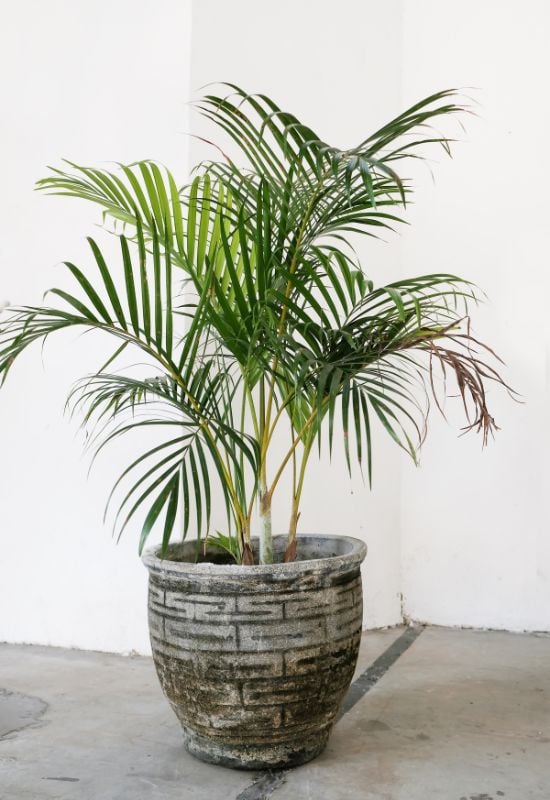
Kentia palm is a very popular houseplant, and it is not at all toxic to cats; actually, it could be beneficial to you and your pets, as demonstrated in a study by Dr. GeunSug Oh and Dr. Gin Joo Jung called ‘Experimental Study on Variation of CO2 Concentration in the Presence of Indoor Plants and Respiration of Experimental Animals’ (Horticulture, Environment and Biotechnology, vol 52(3), June 2011).
A long title to tell you that it purifies the air! Excellent with its pinnate and softly arching deep green fronds in urban environments and if you or your pets have some breathing issues…
What is more, this variety from Australia has soft foliage compared to other palms; this will prevent any accidental scratch or cut in case your little friend gets messy when he plays… At first, it will give you a shrubby shape, but it will then develop into a small tree, keeping its tropical underbrush and leafy look all the way…
Yet another easy to grow, easy to find and cheap (!!!) indoor tree variety that’s even good for your cats, kentia palm can work well in most rooms, including office and living spaces, as it will also keel small in containers.
3: Money Tree (Pachira aquatica)
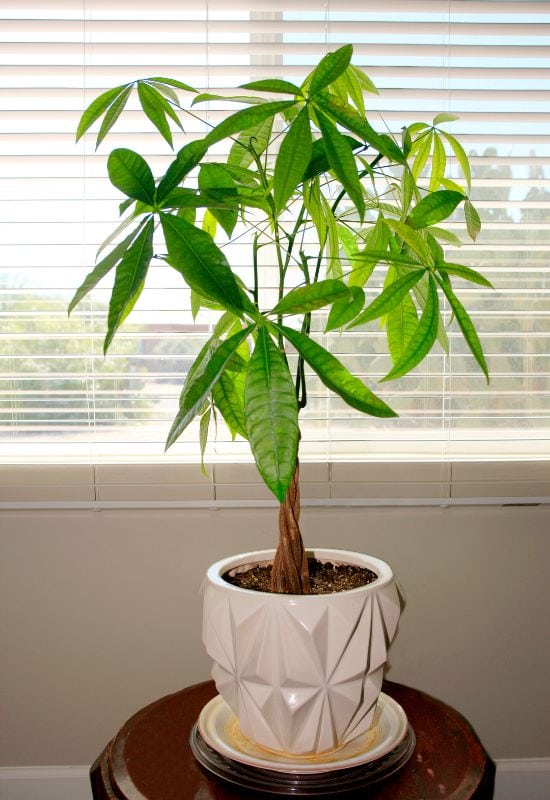
A very popular houseplant, money tree is said to bring good luck, and maybe this is valid for your cats as well… Leaving tradition aside, this exotic species from wet and swampy areas of Central and South America shows no signs of toxicity, and it too has received the safety seal for pets by the ASPCA.
It has become very popular to plait its long chestnut brown trunk, which also adds a very artistic and even sculptural dimension to this leafy indoor variety.
But, of course, it also has very showy digitate leaves, that look like fans, or hands, and they are very glossy and deep emerald in color, wonderful when they hang from the branches from the top… Each of the 5 to 9 leaflets can reach 10 inches long (25 cm), giving your room and pets the full exotic treatment. Good to purify the air, and with no other signs of threat in sight (thorns or sharp edges), your whole family will benefit from it, including feline members.
A positive presence in any indoor space, money tree can decorate formal and informal rooms alike, given its natural (and enhanced) personality, and your cats can safely play around it running no risks.
4: Dwarf Royal Palm (Veitchia Merrillii)
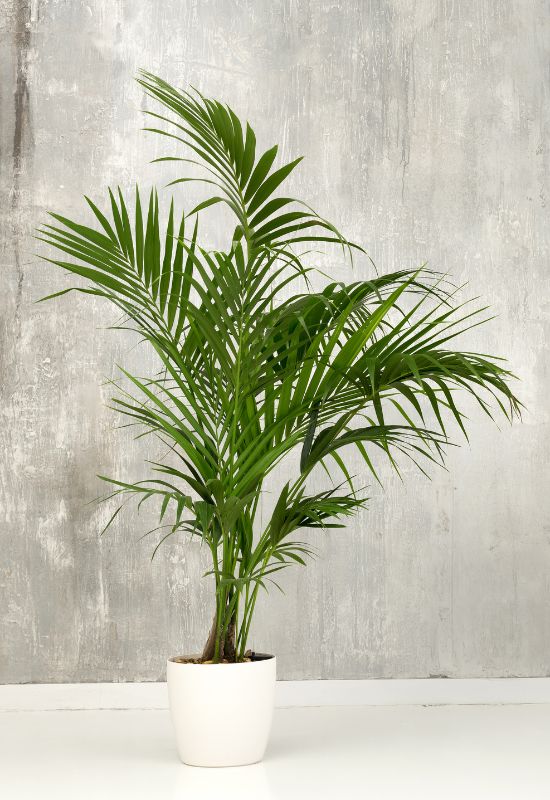
Dwarf royal palm is fully non toxic and safe for humans and pets. Actually, it contains antioxidants, according to Dr. Ali Vafaei of the University of Malaya, Kuala Lumpur (Antioxidant and Citotoxicity Activities of Veitchiamerrillii, 2013)!
But it is really elegant! Its long and arching, pinnate leaves form a decorative rosette, bright to mid green in color, and with fine and fairly stiff rising leaflets that form a V shape, almost sculptural in quality and certainly very decorative…
Its flowers come in masses of cream white, fluffy looking blossoms, though this rarely happens indoors, and they are followed by amazing clusters of carmine red drupes (fruits) but they are not edible… Under all this… Ok, here’s the strange fact…
The lower part of the trunk is grayish and with horizontal stripes of a papery bark, but the upper part is smooth like marble and pea green! And where these two parts meet, it blooms…
A fully safe tree to have indoors, as confirmed by the ASPCA, dwarf royal palm is both sculptural and elegant… In a way, like cats! Its super exotic look makes it ideal for a well lit room; you will need plenty of room though, because it can grow quite fast…
5: Pony Tail Palm (Beaucarnea Recurvata)
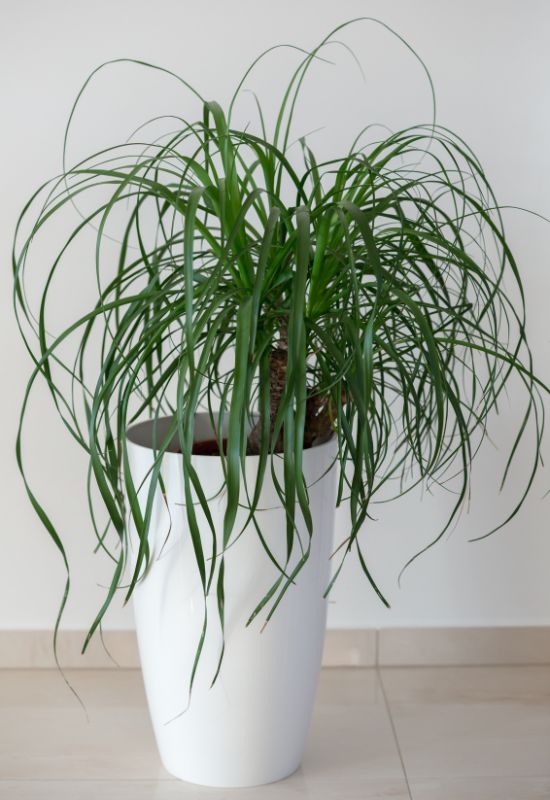
World famous pony tail palm is toxic! But only to rabbits, and not cats… This has been established by Rostami, A., Anderstani, B.Z., and Mohyedini S., in ‘Poisoning by Beaucarnearecurvata, in a New Case Report’ (Comparative Clinical Pathology, vol 20(4), August 2011).
So, unless you also have a little bunny, you can safely enjoy it at home! Its trunk is quite a feat, because it bulges enormously and sculpturally at the base, like a pseudo bulb – in fact it is also called elephant’s foot.
And this is one of the reasons why it is a popular houseplant, with a grayish and cracked but tough bark that can even withstand the sharp nails felines when they file them, which is an extra plus.
Native of Mexico, Belize and Guatemala, this winner of the Award of Garden Merit by the Royal Horticultural Society also gives you a florid tuft of long bright green leaves that arch and droop beautifully from the top, forming a little forest in the sky, and this is where it takes its name…
A naturally small and slow growing tree, it can stay for years and years in your living room with your pets before it reaches full height…
Mixing the rainforest and sunny beach looks, pony tail palm looks wonderful in a well lit room, and when it is small, you can even have it on a table, and not worry that your cats run any risks if they walk on it.
6: Chinese Windmill Palm (Trachycarpus fortunei)
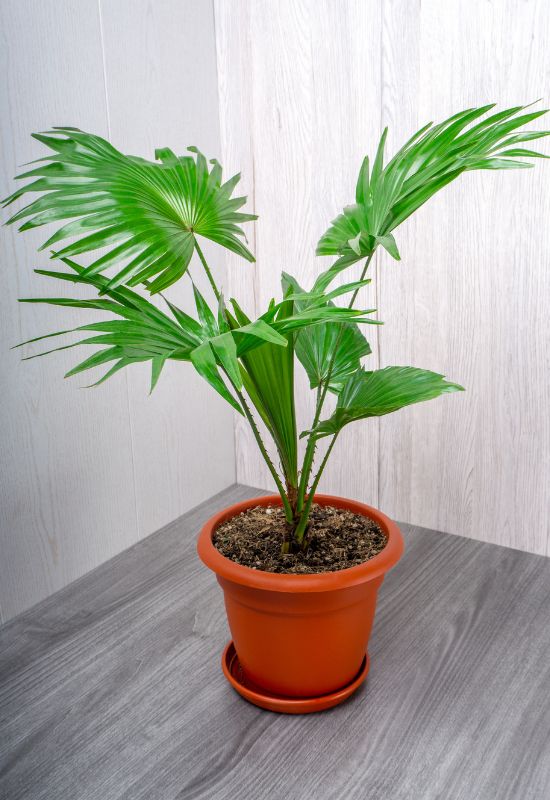
There are many reasons why Chinese windmill palm is an outdoor and indoor favorite. To start with, it is an easy to grow and cold hardy variety (from China, of course), and it is safe for cats.
In fact, the ASPCA puts it in the list of plants that are not toxic to pets, but we need to talk about its decorative value… The main asset it offers to your home or office is the fan like leaves it grows… They are really artistic and, in the wild, they can become massive too, up to 3 feet across (90 cm), so expect big foliage indoors as well.
The blade like leaflets arequite stiff and bright green, but not hard enough to pose any threat to your pets, also because they will come at the top of a tall and straight trunk.
Talking about it, it will cover with a fibrous coat, and your feline friends may find it a good place to file their nails… Like many other exotictrees, it will not blossom in closed environments, which is sad, because the massive clusters of butter yellow flowers it produces are jaw dropping indeed!
Winner of the prestigious Award of Garden Merit by the Royal Horticultural Society, Chinese windmill palm is one of the most exotic trees you can have indoors if you care for your cat’s safety, and it will turn your living room into a sandy and sunny beach on an tropical island.
7: Pigmy Date Palm (Phoenix roebelenii)
Loved for gardens and as a houseplant, pigmy date palm is so sweet that it will never harm your cats! I mean literally, because the drupes it produces are actually edible… Too rich in sugar for pets, they also rarely appear indoors, as do the massive clusters of greenish blooms that appear…
The same applies to the dense hanging panicles that grow from the top of the trunk, dense and packed with cream colored blossoms, sometimes with pinkish hues as well… The upright column it forms is very decorative as well, with a diamond shaped pattern woody produced left over by fallen foliage.
Above the whole you will find a spectacular crown of bright to mid green and glossy leaves, that curve and descend at the sides, while they become more and more upright as you move to the center.
The foliage can form an almost perfect sphere in older specimens, and a real asset to any indoor space. The leaflets are long and pointed and they arch on the sides, like tropical looking fronds.
These will keep well above your pet’s head, though it is quite a small species, that will keep under your roof. And no part of this tropical beauty has any toxic or poisonous substance.
A very popular variety, pigmy date palm will give you that picture perfect tropical beach vibe, so you can give your cat an idea of what life would be like if you moved to an atoll in the Pacific Ocean.
8: Figleaf Palm (Fatsia japonica)
Figleaf palm is not actually a palm, and not even a tree… However, this shrub from Japan is usually grown as a small tree indoors, while outdoors, gardeners like to let it spread and become bushy… Fully safe for cats and on the ASPCA list of innocuous varieties for domestic felines, you can see why this member of the Araliaceae family lends itself to both functions… Its leaves are huge, even more than 14 inches across (35 cm)!
They look soft, and indeed they are to the touch, which makes it pleasant and hazard free for jumping and running kittens. Palmate and with 7 to 9 long, finger like lobes, they make a very dense canopy, like you would find in a tropical rainforest.
Leathery and very glossy indeed, the foliage is held almost horizontal by strong but flexible petioles, yet another guarantee that no accident can occur. You can buy it already trained to grow into a tree shape, or just select one stem to turn into an upright trunk. It rarely flowers in closed spaces, but it if does, it will produce fluffy white blossoms followed by dark, almost black and shiny berries.
Loved for its lush and showy foliage, figleaf palm could even be a good choice to grow over your cat’s bed, because it will give it an enclosed and sheltered place where she or he can dream of exploring leafy and exotic forests.
9: Areca Palm (Dypsis Lutescens)
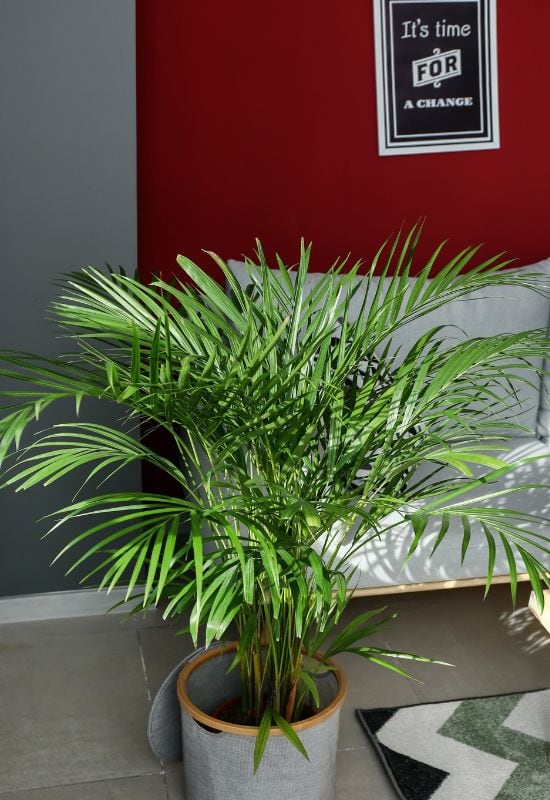
Also called golden butterfly palm and bamboo palm, Areca palm is native of Madagascar and another species that the ASPCA guarantees is safe, non toxic and non poisonous for any pets (or humans).
And it is also a very popular small indoor tree… In fact, it is a classic, also when it comes to its looks. The pinnate leaves rise and arch in a decorative and finely cut tuft, with long, blade like but fairly soft leaflets.
These too will cause no risk for playing cats and kittens, but they will give you their deep and rich green color, which almost shines on the smooth surface they display. While it will offer you a tropical forest feel and style, with a hint at sunny beaches too, it will not blossom indoors.
And it’s a pity, because when they become large in gardens, they produce lots of drooping clusters of golden greenish blossoms that hang from under the the fronds, which produce fruits that ripen to orange and change many colors on the way. These too contain no dangerous chemicals, in case yours decides to change habit…
Yet another easy to grow indoor favorite, Areca palm can work as a gentle and elegant companion or even as backdrop in any well lit room where your cats can go in all safety.
10: Bottlebrush (Callistemon spp.)
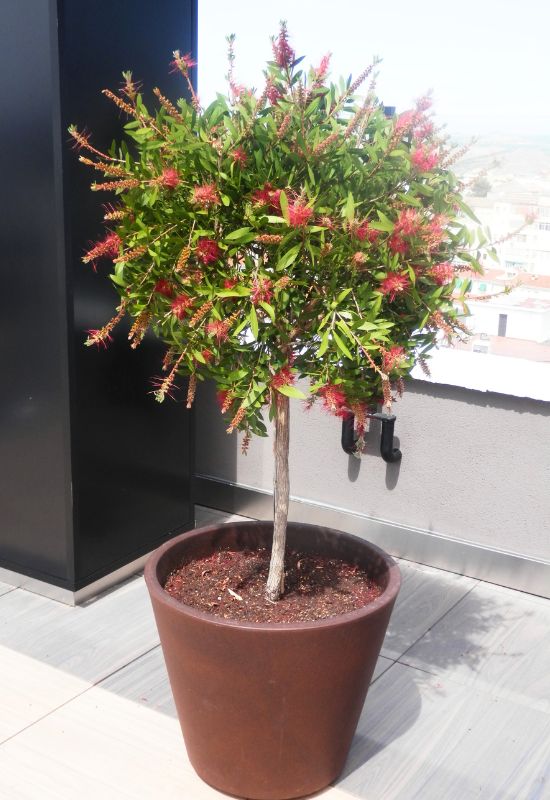
Cat friendly bottlebrush is very original indeed, and mostly kept outdoors in hot climates, but you can grow it indoors too, and there are even dwarf varieties like ‘Little John’ (Callistemon viminalis ‘Little John’) if you have little space.
It will share it safely with your feline friends, because it is non toxic, and its ovate leaves that grow on the branches pose no threat at all. These usually come in green or even blue, depending on the variety, but it is famous for another reason… It blossoms all year round, with fluffy bottle brush like inflorescences in white, pink, rose or scarlet red!
These too will never harm your four legged friends, but you may find that they will want to play with them… And don’t worry if your playful let jumps on it to catch them… The bark has no prickles or thorns, nor do the branches.
Bottlebrush is not just non toxic, it even has anti-oxidant effects, as shown on rat experiments in ‘Evaluation of Toxicology, Anti Lipase, and Antioxidant Effects of Callistemon citrinus in Rats Fed with a High-Fructose Diet’, (Ortega-Perez et al. Pharmaceutical biology, vol 60(1), December 2022). Ok, you won’t need it to put your cat in a slimming diet, but it will still give your indoor spaces a splash of color all year round!
11: Red Fruited Palm Lily (Cordyline rubra)
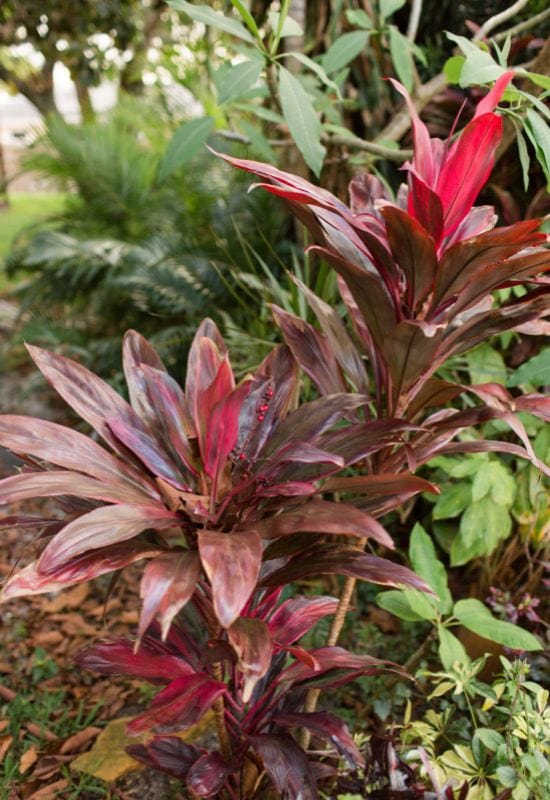
Members of the Cordyline genus, like cabbage tree (Cordyline australis) are usually toxic to cats, dogs and horses, but one, red fruited palm lily is not – and the ASPCA assures us of it.
Again, technically it is not a tree, but it will take the shape of a small one, especially indoors and it is mainly treated as such as a houseplant. And its beauty is hard to resist!
The stem grows upright, like a little straight trunk, but it remains soft, never turning into hardwood, but its main asset are the glossy and large lanceolate foliage.
It will form an energetic and exotic tuft at the top, displaying a jaw dropping range of colors… In fact, the super glossy leaves will give your indoor spaces shades of rose, purple, crimson, even maroon in some cases, and, sometimes, green and even yellow… The under pages tend to be copper, but expect surprises there too.
The fragrant flowers appear in the middle of this kaleidoscopic show, and they range from white to magenta, in long compound clusters. None of this will pose any hazard to your pets, so you can get a fantastic and colorful houseplant without running any risk.
Red fruited palm lily is your best option if you like the tropical tree like shape of Cordyline and you have cats; a focal point in any room, it is also one if not “the” most decorative variety you can grow.
12: Parlor Palm (Chamaedorea Elegans)
Native to tropicalrainforests of Mexico and Guatemala, parlor palm is an ideal houseplant if you have pets at home, including cats and little kittens. To start with, it poses no chemical threats to your little playful friends, as it is totally non toxic, and, again, its foliage won’t harm them at all.
In fact, the leaves come on long and sturdy, arching petioles, and, as the name suggests, they are broad, with softly dented edges, and quite attractive too. Actually, they are pinnate and divided into leaflets, that are long and soft, and without sharp edges.
Rich green and very glossy, it forms a very exotic and really decorative mound. This small clustering tree never grow too tall outdoors, and the same indoors, but it may blossom in the open air, with amazing spider like clusters of cream to pale yellow flowers, but this is rare in enclosed spaces, yet not impossible.
Parlor palm is another indoor tree certified as cat safe by the ASPCA, and it mixes the originality of its frond like leaf shape with a very exotic look, perfect to see your cat’s face appearing from beneath the leaves like a small wild tiger.
Indoor Trees and Cats: A Match Made in Heaven
As long as you choose a non toxic and pet friendly variety, you can easily turn your indoor spaces into leafy, colorful and even tropical looking heavens… But you need to be safe, and only pick indoor trees (and other houseplants) that will pose no threat to them.
Here are 12 you can grow without worrying all the time, and 12 of the mist decorative. As you can see, there are many palms, and no succulents… There is a reason for it… Many succulents are toxic, even Aloe vera and chamomile, which are great for humans, as we have seen.
So, if you are in doubt, before buying a plant, always check with the ASPCA. And with this final tip, I wish you and your cat or kitten the best of luck in a safe but green home!

Written By
Amber Noyes
Amber Noyes was born and raised in a suburban California town, San Mateo. She holds a master’s degree in horticulture from the University of California as well as a BS in Biology from the University of San Francisco. With experience working on an organic farm, water conservation research, farmers’ markets, and plant nursery, she understands what makes plants thrive and how we can better understand the connection between microclimate and plant health. When she’s not on the land, Amber loves informing people of new ideas/things related to gardening, especially organic gardening, houseplants, and growing plants in a small space.

